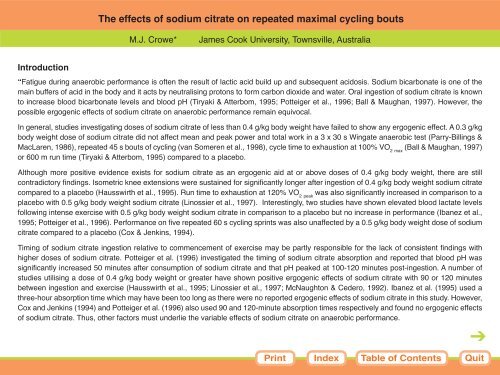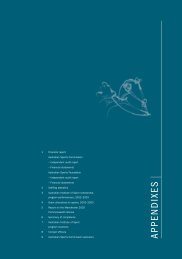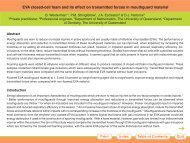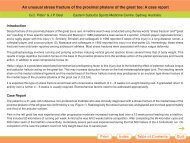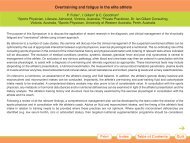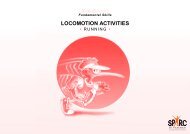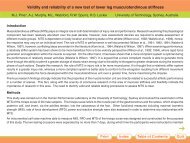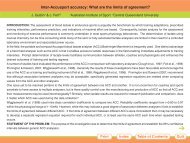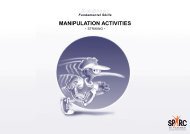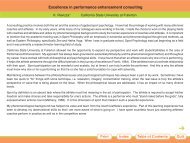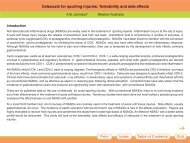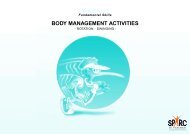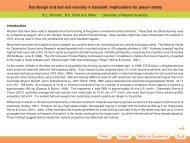The effects of sodium citrate on repeated maximal cycling bouts
The effects of sodium citrate on repeated maximal cycling bouts
The effects of sodium citrate on repeated maximal cycling bouts
You also want an ePaper? Increase the reach of your titles
YUMPU automatically turns print PDFs into web optimized ePapers that Google loves.
Introducti<strong>on</strong><br />
<str<strong>on</strong>g>The</str<strong>on</strong>g> <str<strong>on</strong>g>effects</str<strong>on</strong>g> <str<strong>on</strong>g>of</str<strong>on</strong>g> <str<strong>on</strong>g>sodium</str<strong>on</strong>g> <str<strong>on</strong>g>citrate</str<strong>on</strong>g> <strong>on</strong> <strong>repeated</strong> <strong>maximal</strong> <strong>cycling</strong> <strong>bouts</strong><br />
M.J. Crowe* James Cook University, Townsville, Australia<br />
“Fatigue during anaerobic performance is <str<strong>on</strong>g>of</str<strong>on</strong>g>ten the result <str<strong>on</strong>g>of</str<strong>on</strong>g> lactic acid build up and subsequent acidosis. Sodium bicarb<strong>on</strong>ate is <strong>on</strong>e <str<strong>on</strong>g>of</str<strong>on</strong>g> the<br />
main buffers <str<strong>on</strong>g>of</str<strong>on</strong>g> acid in the body and it acts by neutralising prot<strong>on</strong>s to form carb<strong>on</strong> dioxide and water. Oral ingesti<strong>on</strong> <str<strong>on</strong>g>of</str<strong>on</strong>g> <str<strong>on</strong>g>sodium</str<strong>on</strong>g> <str<strong>on</strong>g>citrate</str<strong>on</strong>g> is known<br />
to increase blood bicarb<strong>on</strong>ate levels and blood pH (Tiryaki & Atterbom, 1995; Potteiger et al., 1996; Ball & Maughan, 1997). However, the<br />
possible ergogenic <str<strong>on</strong>g>effects</str<strong>on</strong>g> <str<strong>on</strong>g>of</str<strong>on</strong>g> <str<strong>on</strong>g>sodium</str<strong>on</strong>g> <str<strong>on</strong>g>citrate</str<strong>on</strong>g> <strong>on</strong> anaerobic performance remain equivocal.<br />
In general, studies investigating doses <str<strong>on</strong>g>of</str<strong>on</strong>g> <str<strong>on</strong>g>sodium</str<strong>on</strong>g> <str<strong>on</strong>g>citrate</str<strong>on</strong>g> <str<strong>on</strong>g>of</str<strong>on</strong>g> less than 0.4 g/kg body weight have failed to show any ergogenic effect. A 0.3 g/kg<br />
body weight dose <str<strong>on</strong>g>of</str<strong>on</strong>g> <str<strong>on</strong>g>sodium</str<strong>on</strong>g> <str<strong>on</strong>g>citrate</str<strong>on</strong>g> did not affect mean and peak power and total work in a 3 x 30 s Wingate anaerobic test (Parry-Billings &<br />
MacLaren, 1986), <strong>repeated</strong> 45 s <strong>bouts</strong> <str<strong>on</strong>g>of</str<strong>on</strong>g> <strong>cycling</strong> (van Someren et al., 1998), cycle time to exhausti<strong>on</strong> at 100% VO 2 max (Ball & Maughan, 1997)<br />
or 600 m run time (Tiryaki & Atterbom, 1995) compared to a placebo.<br />
Although more positive evidence exists for <str<strong>on</strong>g>sodium</str<strong>on</strong>g> <str<strong>on</strong>g>citrate</str<strong>on</strong>g> as an ergogenic aid at or above doses <str<strong>on</strong>g>of</str<strong>on</strong>g> 0.4 g/kg body weight, there are still<br />
c<strong>on</strong>tradictory findings. Isometric knee extensi<strong>on</strong>s were sustained for significantly l<strong>on</strong>ger after ingesti<strong>on</strong> <str<strong>on</strong>g>of</str<strong>on</strong>g> 0.4 g/kg body weight <str<strong>on</strong>g>sodium</str<strong>on</strong>g> <str<strong>on</strong>g>citrate</str<strong>on</strong>g><br />
compared to a placebo (Hausswirth et al., 1995). Run time to exhausti<strong>on</strong> at 120% VO 2 peak was also significantly increased in comparis<strong>on</strong> to a<br />
placebo with 0.5 g/kg body weight <str<strong>on</strong>g>sodium</str<strong>on</strong>g> <str<strong>on</strong>g>citrate</str<strong>on</strong>g> (Linossier et al., 1997). Interestingly, two studies have shown elevated blood lactate levels<br />
following intense exercise with 0.5 g/kg body weight <str<strong>on</strong>g>sodium</str<strong>on</strong>g> <str<strong>on</strong>g>citrate</str<strong>on</strong>g> in comparis<strong>on</strong> to a placebo but no increase in performance (Ibanez et al.,<br />
1995; Potteiger et al., 1996). Performance <strong>on</strong> five <strong>repeated</strong> 60 s <strong>cycling</strong> sprints was also unaffected by a 0.5 g/kg body weight dose <str<strong>on</strong>g>of</str<strong>on</strong>g> <str<strong>on</strong>g>sodium</str<strong>on</strong>g><br />
<str<strong>on</strong>g>citrate</str<strong>on</strong>g> compared to a placebo (Cox & Jenkins, 1994).<br />
Timing <str<strong>on</strong>g>of</str<strong>on</strong>g> <str<strong>on</strong>g>sodium</str<strong>on</strong>g> <str<strong>on</strong>g>citrate</str<strong>on</strong>g> ingesti<strong>on</strong> relative to commencement <str<strong>on</strong>g>of</str<strong>on</strong>g> exercise may be partly resp<strong>on</strong>sible for the lack <str<strong>on</strong>g>of</str<strong>on</strong>g> c<strong>on</strong>sistent findings with<br />
higher doses <str<strong>on</strong>g>of</str<strong>on</strong>g> <str<strong>on</strong>g>sodium</str<strong>on</strong>g> <str<strong>on</strong>g>citrate</str<strong>on</strong>g>. Potteiger et al. (1996) investigated the timing <str<strong>on</strong>g>of</str<strong>on</strong>g> <str<strong>on</strong>g>sodium</str<strong>on</strong>g> <str<strong>on</strong>g>citrate</str<strong>on</strong>g> absorpti<strong>on</strong> and reported that blood pH was<br />
significantly increased 50 minutes after c<strong>on</strong>sumpti<strong>on</strong> <str<strong>on</strong>g>of</str<strong>on</strong>g> <str<strong>on</strong>g>sodium</str<strong>on</strong>g> <str<strong>on</strong>g>citrate</str<strong>on</strong>g> and that pH peaked at 100-120 minutes post-ingesti<strong>on</strong>. A number <str<strong>on</strong>g>of</str<strong>on</strong>g><br />
studies utilising a dose <str<strong>on</strong>g>of</str<strong>on</strong>g> 0.4 g/kg body weight or greater have shown positive ergogenic <str<strong>on</strong>g>effects</str<strong>on</strong>g> <str<strong>on</strong>g>of</str<strong>on</strong>g> <str<strong>on</strong>g>sodium</str<strong>on</strong>g> <str<strong>on</strong>g>citrate</str<strong>on</strong>g> with 90 or 120 minutes<br />
between ingesti<strong>on</strong> and exercise (Hausswirth et al., 1995; Linossier et al., 1997; McNaught<strong>on</strong> & Cedero, 1992). Ibanez et al. (1995) used a<br />
three-hour absorpti<strong>on</strong> time which may have been too l<strong>on</strong>g as there were no reported ergogenic <str<strong>on</strong>g>effects</str<strong>on</strong>g> <str<strong>on</strong>g>of</str<strong>on</strong>g> <str<strong>on</strong>g>sodium</str<strong>on</strong>g> <str<strong>on</strong>g>citrate</str<strong>on</strong>g> in this study. However,<br />
Cox and Jenkins (1994) and Potteiger et al. (1996) also used 90 and 120-minute absorpti<strong>on</strong> times respectively and found no ergogenic <str<strong>on</strong>g>effects</str<strong>on</strong>g><br />
<str<strong>on</strong>g>of</str<strong>on</strong>g> <str<strong>on</strong>g>sodium</str<strong>on</strong>g> <str<strong>on</strong>g>citrate</str<strong>on</strong>g>. Thus, other factors must underlie the variable <str<strong>on</strong>g>effects</str<strong>on</strong>g> <str<strong>on</strong>g>of</str<strong>on</strong>g> <str<strong>on</strong>g>sodium</str<strong>on</strong>g> <str<strong>on</strong>g>citrate</str<strong>on</strong>g> <strong>on</strong> anaerobic performance.<br />
Print<br />
Index<br />
Table <str<strong>on</strong>g>of</str<strong>on</strong>g> C<strong>on</strong>tents<br />
Quit
<str<strong>on</strong>g>The</str<strong>on</strong>g> <str<strong>on</strong>g>effects</str<strong>on</strong>g> <str<strong>on</strong>g>of</str<strong>on</strong>g> <str<strong>on</strong>g>sodium</str<strong>on</strong>g> <str<strong>on</strong>g>citrate</str<strong>on</strong>g> <strong>on</strong> <strong>repeated</strong> <strong>maximal</strong> <strong>cycling</strong> <strong>bouts</strong><br />
M.J. Crowe* James Cook University, Townsville, Australia<br />
Durati<strong>on</strong> <str<strong>on</strong>g>of</str<strong>on</strong>g> exercise may play a role in determining the effectiveness <str<strong>on</strong>g>of</str<strong>on</strong>g> <str<strong>on</strong>g>sodium</str<strong>on</strong>g> <str<strong>on</strong>g>citrate</str<strong>on</strong>g> as an ergogenic. McNaught<strong>on</strong> and Cedero (1992) found<br />
a positive effect <str<strong>on</strong>g>of</str<strong>on</strong>g> 0.5 g/kg body weight <str<strong>on</strong>g>sodium</str<strong>on</strong>g> <str<strong>on</strong>g>citrate</str<strong>on</strong>g> <strong>on</strong> <strong>maximal</strong> <strong>cycling</strong> <str<strong>on</strong>g>of</str<strong>on</strong>g> 120 s and 240 s durati<strong>on</strong> but no effect when exercise durati<strong>on</strong> was<br />
10 s or 30 s. <str<strong>on</strong>g>The</str<strong>on</strong>g>refore, exercise must be <str<strong>on</strong>g>of</str<strong>on</strong>g> sufficient durati<strong>on</strong> to elicit a substantial lactic acid resp<strong>on</strong>se.<br />
Statement <str<strong>on</strong>g>of</str<strong>on</strong>g> the Problem<br />
Equivocal evidence exists as to the potential ergogenic <str<strong>on</strong>g>effects</str<strong>on</strong>g> <str<strong>on</strong>g>of</str<strong>on</strong>g> <str<strong>on</strong>g>sodium</str<strong>on</strong>g> <str<strong>on</strong>g>citrate</str<strong>on</strong>g> <strong>on</strong> anaerobic performance. Doses <str<strong>on</strong>g>of</str<strong>on</strong>g> <str<strong>on</strong>g>sodium</str<strong>on</strong>g> <str<strong>on</strong>g>citrate</str<strong>on</strong>g> equal to or<br />
greater than 0.4 g/kg body weight with an absorpti<strong>on</strong> time <str<strong>on</strong>g>of</str<strong>on</strong>g> 90-120 minutes and exercise durati<strong>on</strong> l<strong>on</strong>ger than 30 s appear to enhance<br />
anaerobic performance. <str<strong>on</strong>g>The</str<strong>on</strong>g>refore, this study aimed to investigate the <str<strong>on</strong>g>effects</str<strong>on</strong>g> <str<strong>on</strong>g>of</str<strong>on</strong>g> a 0.5 g/kg body weight dose <str<strong>on</strong>g>of</str<strong>on</strong>g> <str<strong>on</strong>g>sodium</str<strong>on</strong>g> <str<strong>on</strong>g>citrate</str<strong>on</strong>g> <strong>on</strong> three<br />
<strong>repeated</strong> 30 s <strong>maximal</strong> <strong>cycling</strong> <strong>bouts</strong> with an absorpti<strong>on</strong> time <str<strong>on</strong>g>of</str<strong>on</strong>g> 90 minutes. Under these c<strong>on</strong>diti<strong>on</strong>s, it was expected that <str<strong>on</strong>g>sodium</str<strong>on</strong>g> <str<strong>on</strong>g>citrate</str<strong>on</strong>g> would<br />
cause an increase in peak power, total work and blood lactate in comparis<strong>on</strong> to a placebo.<br />
Methods<br />
<str<strong>on</strong>g>The</str<strong>on</strong>g> subjects in this study were 20 healthy students (12 male and 8 female). <str<strong>on</strong>g>The</str<strong>on</strong>g> mean (± SD) age <str<strong>on</strong>g>of</str<strong>on</strong>g> the subjects was 22.3 ± 3.8 years and<br />
mean body weight was 75.5 ± 18.9 kg. Participati<strong>on</strong> was <strong>on</strong> a volunteer basis with subjects providing informed c<strong>on</strong>sent after the procedures <str<strong>on</strong>g>of</str<strong>on</strong>g><br />
the study were explained. <str<strong>on</strong>g>The</str<strong>on</strong>g> study was approved by the James Cook University Ethics Committee.<br />
<str<strong>on</strong>g>The</str<strong>on</strong>g> subjects first performed a familiarisati<strong>on</strong> sessi<strong>on</strong> where they were asked to warm up <strong>on</strong> a cycle ergometer (Repco) at a moderate pace for<br />
3-5 minutes. <str<strong>on</strong>g>The</str<strong>on</strong>g> subjects then commenced a 3 x 30 s <strong>maximal</strong> cycle test with verbal encouragement from the experimenters and 30 s rest<br />
periods between <strong>bouts</strong>. No measurements were taken during this sessi<strong>on</strong>.<br />
<str<strong>on</strong>g>The</str<strong>on</strong>g> subjects returned to the laboratory seven days after the familiarisati<strong>on</strong> sessi<strong>on</strong> to perform baseline testing. <str<strong>on</strong>g>The</str<strong>on</strong>g> protocol for baseline<br />
testing was identical to that <str<strong>on</strong>g>of</str<strong>on</strong>g> the familiarisati<strong>on</strong> sessi<strong>on</strong>. Peak heart rate was recorded for each 30 s exercise bout using a heart rate m<strong>on</strong>itor<br />
(Polar Vantage). Peak power (watts/kg) and total work (joules/kg) were recorded using a Repco Superm<strong>on</strong>itor for each exercise bout. A finger<br />
prick blood sample was taken at three and six minutes after completi<strong>on</strong> <str<strong>on</strong>g>of</str<strong>on</strong>g> the third 30 s exercise bout to ascertain blood lactate levels using an<br />
Acusport blood lactate tester. <str<strong>on</strong>g>The</str<strong>on</strong>g> highest blood lactate value from the three and six minute samples was used in the analysis. <str<strong>on</strong>g>The</str<strong>on</strong>g> subjects<br />
were encouraged to c<strong>on</strong>tinue <strong>cycling</strong> at a slow pace for several minutes to warm down after completi<strong>on</strong> <str<strong>on</strong>g>of</str<strong>on</strong>g> the third 30 s exercise bout.<br />
Print<br />
Index<br />
Table <str<strong>on</strong>g>of</str<strong>on</strong>g> C<strong>on</strong>tents<br />
Quit
<str<strong>on</strong>g>The</str<strong>on</strong>g> <str<strong>on</strong>g>effects</str<strong>on</strong>g> <str<strong>on</strong>g>of</str<strong>on</strong>g> <str<strong>on</strong>g>sodium</str<strong>on</strong>g> <str<strong>on</strong>g>citrate</str<strong>on</strong>g> <strong>on</strong> <strong>repeated</strong> <strong>maximal</strong> <strong>cycling</strong> <strong>bouts</strong><br />
M.J. Crowe* James Cook University, Townsville, Australia<br />
Seven days after baseline testing, the subjects returned to the laboratory and c<strong>on</strong>sumed either a 0.5 g/kg body weight dose <str<strong>on</strong>g>of</str<strong>on</strong>g> <str<strong>on</strong>g>sodium</str<strong>on</strong>g> <str<strong>on</strong>g>citrate</str<strong>on</strong>g><br />
dissolved in a cordial drink (n=10, 7 males and 3 females) or a cordial–<str<strong>on</strong>g>sodium</str<strong>on</strong>g> chloride (0.045 g/kg) placebo (n=10, 5 males and 5 females).<br />
Allocati<strong>on</strong> <str<strong>on</strong>g>of</str<strong>on</strong>g> <str<strong>on</strong>g>citrate</str<strong>on</strong>g> or placebo was performed in a double-blind manner. A period <str<strong>on</strong>g>of</str<strong>on</strong>g> 90 minutes elapsed between c<strong>on</strong>sumpti<strong>on</strong> <str<strong>on</strong>g>of</str<strong>on</strong>g> the cordial<br />
drink and retesting with the 3 x 30 s <strong>maximal</strong> cycle test. Testing was performed in an identical manner to the baseline testing.<br />
Comparis<strong>on</strong> <str<strong>on</strong>g>of</str<strong>on</strong>g> peak power, total work and peak blood lactate was made between the <str<strong>on</strong>g>citrate</str<strong>on</strong>g> and placebo groups and the baseline and retest<br />
sessi<strong>on</strong>s using a two-way <strong>repeated</strong> measures ANOVA. Maximal heart rate was compared between all six 30 s exercise <strong>bouts</strong> using a <strong>on</strong>e-way<br />
ANOVA. Statistical significance was set at p 0.05). This indicates a c<strong>on</strong>sistent exercise effort from<br />
the subjects <strong>on</strong> each <str<strong>on</strong>g>of</str<strong>on</strong>g> the three <strong>bouts</strong> at each testing sessi<strong>on</strong>.<br />
Oral ingesti<strong>on</strong> <str<strong>on</strong>g>of</str<strong>on</strong>g> 0.5 g/kg body weight <str<strong>on</strong>g>sodium</str<strong>on</strong>g> <str<strong>on</strong>g>citrate</str<strong>on</strong>g> did not enhance performance <strong>on</strong> the <strong>repeated</strong> <strong>maximal</strong> <strong>cycling</strong> test. Neither peak power<br />
nor total work was significantly higher in the <str<strong>on</strong>g>sodium</str<strong>on</strong>g> <str<strong>on</strong>g>citrate</str<strong>on</strong>g> group compared to the placebo group <strong>on</strong> any <str<strong>on</strong>g>of</str<strong>on</strong>g> the three exercise <strong>bouts</strong> (p > 0.05;<br />
see Table 1). Furthermore, there was no increase in peak power or total work from baseline to retest for the subjects in the <str<strong>on</strong>g>sodium</str<strong>on</strong>g> <str<strong>on</strong>g>citrate</str<strong>on</strong>g> group<br />
(p > 0.05; see Table 1). Similarly, the placebo group did not improve their peak power or total work from the baseline testing sessi<strong>on</strong> to the<br />
repeat testing sessi<strong>on</strong> suggesting that there were no anaerobic adaptati<strong>on</strong>s between exercise sessi<strong>on</strong>s (p > 0.05; see Table 1).<br />
Print<br />
Index<br />
Table <str<strong>on</strong>g>of</str<strong>on</strong>g> C<strong>on</strong>tents<br />
Quit
<str<strong>on</strong>g>The</str<strong>on</strong>g> <str<strong>on</strong>g>effects</str<strong>on</strong>g> <str<strong>on</strong>g>of</str<strong>on</strong>g> <str<strong>on</strong>g>sodium</str<strong>on</strong>g> <str<strong>on</strong>g>citrate</str<strong>on</strong>g> <strong>on</strong> <strong>repeated</strong> <strong>maximal</strong> <strong>cycling</strong> <strong>bouts</strong><br />
M.J. Crowe* James Cook University, Townsville, Australia<br />
repeat testing sessi<strong>on</strong>s for each 30 s exercise bout.<br />
Peak Power (W/kg) Placebo Sodium Citrate<br />
Baseline Testing<br />
Bout 1 12.5 ± 2.0 13.2 ± 2.3<br />
Repeat Testing<br />
Total Work (j/kg)<br />
Baseline Testing<br />
Repeat Testing<br />
Bout 2 8.3 ± 1.9 8.9 ± 1.5<br />
Bout 3 6.5 ± 1.4 7.2 ± 1.7<br />
Bout 1 12.2 ± 1.7 12.5 ± 2.8<br />
Bout 2 8.0 ± 2.1 8.7 ± 2.0<br />
Bout 3 7.0 ± 1.3 7.7 ± 2.0<br />
Bout 1 270.1 ± 41.5 290.3 ± 45.4<br />
Bout 2 169.9 ± 30.0 192.0 ± 42.4<br />
Bout 3 134.9 ± 25.2 172.6 ± 47.3<br />
Bout 1 271.7 ± 40.8 280.2 ± 57.4<br />
Bout 2 167.6 ± 30.9 193.1 ± 44.0<br />
Bout 3 143.0 ± 24.6 146.9 ± 59.1<br />
Table 1. Mean peak power (W/kg) and total work (j/kg) for the <str<strong>on</strong>g>sodium</str<strong>on</strong>g> <str<strong>on</strong>g>citrate</str<strong>on</strong>g> and placebo groups<br />
at the baseline and repeat testing sessi<strong>on</strong>s for each 30 s exercise bout.<br />
Print<br />
Index<br />
Table <str<strong>on</strong>g>of</str<strong>on</strong>g> C<strong>on</strong>tents<br />
Quit
<str<strong>on</strong>g>The</str<strong>on</strong>g> <str<strong>on</strong>g>effects</str<strong>on</strong>g> <str<strong>on</strong>g>of</str<strong>on</strong>g> <str<strong>on</strong>g>sodium</str<strong>on</strong>g> <str<strong>on</strong>g>citrate</str<strong>on</strong>g> <strong>on</strong> <strong>repeated</strong> <strong>maximal</strong> <strong>cycling</strong> <strong>bouts</strong><br />
Blood Lactate (mmol/l)<br />
20<br />
18<br />
16<br />
14<br />
12<br />
10<br />
8<br />
6<br />
4<br />
2<br />
0<br />
M.J. Crowe* James Cook University, Townsville, Australia<br />
Baseline Repeat<br />
Testing Sessi<strong>on</strong><br />
Figure 1. Mean peak blood lactate c<strong>on</strong>centrati<strong>on</strong>s (mmol/l) for all subjects at the baseline and repeat testing sessi<strong>on</strong>s.<br />
Print<br />
Index<br />
Table <str<strong>on</strong>g>of</str<strong>on</strong>g> C<strong>on</strong>tents<br />
Quit
<str<strong>on</strong>g>The</str<strong>on</strong>g> <str<strong>on</strong>g>effects</str<strong>on</strong>g> <str<strong>on</strong>g>of</str<strong>on</strong>g> <str<strong>on</strong>g>sodium</str<strong>on</strong>g> <str<strong>on</strong>g>citrate</str<strong>on</strong>g> <strong>on</strong> <strong>repeated</strong> <strong>maximal</strong> <strong>cycling</strong> <strong>bouts</strong><br />
M.J. Crowe* James Cook University, Townsville, Australia<br />
<str<strong>on</strong>g>The</str<strong>on</strong>g>re was no effect <str<strong>on</strong>g>of</str<strong>on</strong>g> <str<strong>on</strong>g>sodium</str<strong>on</strong>g> <str<strong>on</strong>g>citrate</str<strong>on</strong>g> ingesti<strong>on</strong> <strong>on</strong> the peak blood lactate c<strong>on</strong>centrati<strong>on</strong> when compared to the placebo (p > 0.05). Furthermore,<br />
there was no significant increase in peak blood lactate between baseline testing and repeat testing for the subjects in the <str<strong>on</strong>g>sodium</str<strong>on</strong>g> <str<strong>on</strong>g>citrate</str<strong>on</strong>g> group<br />
(p > 0.05). However, when the <str<strong>on</strong>g>sodium</str<strong>on</strong>g> <str<strong>on</strong>g>citrate</str<strong>on</strong>g> and placebo subjects were grouped together, there was a significant increase in peak blood<br />
lactate from 12.8 ± 3.0 mmol/l at the initial baseline testing sessi<strong>on</strong> to 14.5 ± 3.5 mmol/l at the repeat testing sessi<strong>on</strong> (p = 0.033; see Figure 1).<br />
Sodium <str<strong>on</strong>g>citrate</str<strong>on</strong>g> is <str<strong>on</strong>g>of</str<strong>on</strong>g>ten used in preference to <str<strong>on</strong>g>sodium</str<strong>on</strong>g> bicarb<strong>on</strong>ate because <str<strong>on</strong>g>of</str<strong>on</strong>g> a reported lower incidence <str<strong>on</strong>g>of</str<strong>on</strong>g> gastrointestinal discomfort (Linderman<br />
& Fahey, 1991). It was therefore interesting to note that 6 <str<strong>on</strong>g>of</str<strong>on</strong>g> the 10 subjects who c<strong>on</strong>sumed <str<strong>on</strong>g>sodium</str<strong>on</strong>g> <str<strong>on</strong>g>citrate</str<strong>on</strong>g> in this study reported mild to<br />
moderate diarrhoea. <str<strong>on</strong>g>The</str<strong>on</strong>g> <str<strong>on</strong>g>sodium</str<strong>on</strong>g> <str<strong>on</strong>g>citrate</str<strong>on</strong>g> was delivered to the subjects in 600 ml <str<strong>on</strong>g>of</str<strong>on</strong>g> cordial-flavoured water. It may be possible that this was<br />
insufficient fluid to avoid the gastrointestinal upset experienced by the subjects.<br />
Although the findings <str<strong>on</strong>g>of</str<strong>on</strong>g> this study are in c<strong>on</strong>trast to those <str<strong>on</strong>g>of</str<strong>on</strong>g> Hausswirth et al. (1995) and Linossier et al. (1997) who reported an ergogenic<br />
effect <str<strong>on</strong>g>of</str<strong>on</strong>g> <str<strong>on</strong>g>sodium</str<strong>on</strong>g> <str<strong>on</strong>g>citrate</str<strong>on</strong>g> <strong>on</strong> short-term, intense exercise, they are c<strong>on</strong>sistent with the findings <str<strong>on</strong>g>of</str<strong>on</strong>g> Cox and Jenkins (1994), Ibanez et al. (1995) and<br />
Potteiger et al. (1996) who found no ergogenic effect <str<strong>on</strong>g>of</str<strong>on</strong>g> 0.5 g/kg oral <str<strong>on</strong>g>sodium</str<strong>on</strong>g> <str<strong>on</strong>g>citrate</str<strong>on</strong>g> <strong>on</strong> short-term, intense exercise. In c<strong>on</strong>trast to Potteiger<br />
(1996) and Ibanez et al. (1995), however, is the fact that blood lactate levels were no higher as a result <str<strong>on</strong>g>of</str<strong>on</strong>g> taking <str<strong>on</strong>g>sodium</str<strong>on</strong>g> <str<strong>on</strong>g>citrate</str<strong>on</strong>g>. Sodium <str<strong>on</strong>g>citrate</str<strong>on</strong>g><br />
is known to alkalise the blood (Tiryaki & Atterbom, 1995; Potteiger et al., 1996; Ball & Maughan, 1997) facilitating a pH gradient to draw H + i<strong>on</strong>s<br />
and lactate from the muscle compartment into the blood. Sodium <str<strong>on</strong>g>citrate</str<strong>on</strong>g> does not alkalise the muscle compartment with a 90 minute absorpti<strong>on</strong><br />
time at a dose <str<strong>on</strong>g>of</str<strong>on</strong>g> 0.5 g/kg body weight (Linossier et al., 1997). Thus, it is unlikely that the muscle compartment would have been alkalised in this<br />
study. Under these c<strong>on</strong>diti<strong>on</strong>s, <str<strong>on</strong>g>sodium</str<strong>on</strong>g> <str<strong>on</strong>g>citrate</str<strong>on</strong>g> can <strong>on</strong>ly reduce muscle acidosis by drawing H + and lactate from the muscle cytosol into the<br />
blood. However, this is unlikely to have happened here as higher blood lactate levels were not recorded with <str<strong>on</strong>g>sodium</str<strong>on</strong>g> <str<strong>on</strong>g>citrate</str<strong>on</strong>g>, nor were peak<br />
power or total work elevated as would be expected with increased removal <str<strong>on</strong>g>of</str<strong>on</strong>g> H + from the muscle compartment. <str<strong>on</strong>g>The</str<strong>on</strong>g> subjects in this study were<br />
reas<strong>on</strong>ably anaerobically trained reaching average post-exercise blood lactate levels <str<strong>on</strong>g>of</str<strong>on</strong>g> 13.6 ± 3.3 mmol/l, c<strong>on</strong>centrati<strong>on</strong>s that would be<br />
correlated with a significant drop in pH (not measured here). Thus, if <str<strong>on</strong>g>sodium</str<strong>on</strong>g> <str<strong>on</strong>g>citrate</str<strong>on</strong>g> were an effective buffer able to augment the natural buffers<br />
<str<strong>on</strong>g>of</str<strong>on</strong>g> the body, it would have been expected to show some effect here.<br />
C<strong>on</strong>clusi<strong>on</strong>s<br />
<str<strong>on</strong>g>The</str<strong>on</strong>g> results <str<strong>on</strong>g>of</str<strong>on</strong>g> this study showed that a 0.5 g/kg body weight dose <str<strong>on</strong>g>of</str<strong>on</strong>g> <str<strong>on</strong>g>sodium</str<strong>on</strong>g> <str<strong>on</strong>g>citrate</str<strong>on</strong>g> had no ergogenic effect <strong>on</strong> male and female subjects<br />
performing three <strong>maximal</strong> 30 s <strong>cycling</strong> <strong>bouts</strong> compared to a placebo. Peak blood lactate c<strong>on</strong>centrati<strong>on</strong>s were also unaffected by this dose <str<strong>on</strong>g>of</str<strong>on</strong>g><br />
<str<strong>on</strong>g>sodium</str<strong>on</strong>g> <str<strong>on</strong>g>citrate</str<strong>on</strong>g> under these c<strong>on</strong>diti<strong>on</strong>s.<br />
Print<br />
Index<br />
Table <str<strong>on</strong>g>of</str<strong>on</strong>g> C<strong>on</strong>tents<br />
Quit
References<br />
<str<strong>on</strong>g>The</str<strong>on</strong>g> <str<strong>on</strong>g>effects</str<strong>on</strong>g> <str<strong>on</strong>g>of</str<strong>on</strong>g> <str<strong>on</strong>g>sodium</str<strong>on</strong>g> <str<strong>on</strong>g>citrate</str<strong>on</strong>g> <strong>on</strong> <strong>repeated</strong> <strong>maximal</strong> <strong>cycling</strong> <strong>bouts</strong><br />
M.J. Crowe* James Cook University, Townsville, Australia<br />
Ball, D. & Maughan, R. J. (1997) <str<strong>on</strong>g>The</str<strong>on</strong>g> effect <str<strong>on</strong>g>of</str<strong>on</strong>g> <str<strong>on</strong>g>sodium</str<strong>on</strong>g> <str<strong>on</strong>g>citrate</str<strong>on</strong>g> ingesti<strong>on</strong> <strong>on</strong> the metabolic resp<strong>on</strong>se to intense exercise following diet manipulati<strong>on</strong><br />
in man. Exp. Physiol. 82(6): 1041-1056.<br />
Cox, G. & Jenkins, D. G. (1994) <str<strong>on</strong>g>The</str<strong>on</strong>g> physiological and ventilatory resp<strong>on</strong>ses to <strong>repeated</strong> 60 s sprints following <str<strong>on</strong>g>sodium</str<strong>on</strong>g> <str<strong>on</strong>g>citrate</str<strong>on</strong>g> ingesti<strong>on</strong>. J.<br />
Sports. Sci. 12(5): 469-475.<br />
Hausswirth. C., Bigard, A. X., Lepers, R., Berthelot, M. & Guezennec, C. Y. (1995) Sodium <str<strong>on</strong>g>citrate</str<strong>on</strong>g> ingesti<strong>on</strong> and muscle performance in acute<br />
hypobaric hypoxia. Eur. J. Appl. Physiol. 71(4): 362-368.<br />
Ibanez, J., Pullinen, T., Gorostiaga, E., Postigo, A. & Mero, A. (1995) Blood lactate and amm<strong>on</strong>ia in short-term anaerobic work following<br />
induced alkalosis. J. Sports Med. Phys. Fitness. 35(3): 187-193.<br />
Linderman, J. K. & Fahey, T. D. (1991) Sodium bicarb<strong>on</strong>ate ingesti<strong>on</strong> and exercise performance: an update. Sports Med. 11: 71-77.<br />
Linossier, M. T., Dormois, D., Bregere, P., Geyssant, A. & Denis, C. (1997) Effect <str<strong>on</strong>g>of</str<strong>on</strong>g> <str<strong>on</strong>g>sodium</str<strong>on</strong>g> <str<strong>on</strong>g>citrate</str<strong>on</strong>g> <strong>on</strong> performance and metabolism <str<strong>on</strong>g>of</str<strong>on</strong>g> human<br />
skeletal muscle during supra<strong>maximal</strong> <strong>cycling</strong> exercise. Eur. J. Appl. Physiol. 76(1): 48-54.<br />
McNaught<strong>on</strong>, L. & Cedero, R. (1992). Sodium <str<strong>on</strong>g>citrate</str<strong>on</strong>g> ingesti<strong>on</strong>s and its <str<strong>on</strong>g>effects</str<strong>on</strong>g> <strong>on</strong> <strong>maximal</strong> anaerobic exercise <str<strong>on</strong>g>of</str<strong>on</strong>g> different durati<strong>on</strong>s. Eur. J.<br />
Appl. Physiol. 64(1): 36-41.<br />
Parry-Billings, M. & MacLaren, D. P. (1986) <str<strong>on</strong>g>The</str<strong>on</strong>g> effect <str<strong>on</strong>g>of</str<strong>on</strong>g> <str<strong>on</strong>g>sodium</str<strong>on</strong>g> bicarb<strong>on</strong>ate and <str<strong>on</strong>g>sodium</str<strong>on</strong>g> <str<strong>on</strong>g>citrate</str<strong>on</strong>g> ingesti<strong>on</strong> <strong>on</strong> anaerobic power during intermittent<br />
exercise. Eur. J. Appl. Physiol. 55(5): 524-529.<br />
Potteiger, J. A., Webster, M. J., Nickel, G. L., Haub, M. D. & Palmer, R. J. (1996) <str<strong>on</strong>g>The</str<strong>on</strong>g> <str<strong>on</strong>g>effects</str<strong>on</strong>g> <str<strong>on</strong>g>of</str<strong>on</strong>g> buffer ingesti<strong>on</strong> <strong>on</strong> metabolic factors related to<br />
distance running performance. Eur. J. Appl. Physiol. 72(4): 365-371.<br />
Tiryaki, G. R. & Atterbom, H. A. (1995) <str<strong>on</strong>g>The</str<strong>on</strong>g> <str<strong>on</strong>g>effects</str<strong>on</strong>g> <str<strong>on</strong>g>of</str<strong>on</strong>g> <str<strong>on</strong>g>sodium</str<strong>on</strong>g> bicarb<strong>on</strong>ate and <str<strong>on</strong>g>sodium</str<strong>on</strong>g> <str<strong>on</strong>g>citrate</str<strong>on</strong>g> <strong>on</strong> 600 m running time <str<strong>on</strong>g>of</str<strong>on</strong>g> trained females. J.<br />
Sports Med. Phys. Fitness. 35(3): 194-198.<br />
van Someren, K., Fulcher, K., McCarthy, J., Moore, J., Horgan, G. & Langford, R. (1998) An investigati<strong>on</strong> into the <str<strong>on</strong>g>effects</str<strong>on</strong>g> <str<strong>on</strong>g>of</str<strong>on</strong>g> <str<strong>on</strong>g>sodium</str<strong>on</strong>g> <str<strong>on</strong>g>citrate</str<strong>on</strong>g><br />
ingesti<strong>on</strong> <strong>on</strong> high-intensity exercise performance. Int. J. Sports Nutr. 8(4): 356-363.<br />
Print<br />
Index<br />
Table <str<strong>on</strong>g>of</str<strong>on</strong>g> C<strong>on</strong>tents<br />
Quit
<str<strong>on</strong>g>The</str<strong>on</strong>g> <str<strong>on</strong>g>effects</str<strong>on</strong>g> <str<strong>on</strong>g>of</str<strong>on</strong>g> <str<strong>on</strong>g>sodium</str<strong>on</strong>g> <str<strong>on</strong>g>citrate</str<strong>on</strong>g> <strong>on</strong> <strong>repeated</strong> <strong>maximal</strong> <strong>cycling</strong> <strong>bouts</strong><br />
M.J. Crowe*<br />
James Cook University, Townsville, Australia<br />
INTRODUCTION: Fatigue during anaerobic performance is <str<strong>on</strong>g>of</str<strong>on</strong>g>ten the result <str<strong>on</strong>g>of</str<strong>on</strong>g> lactic acid build up and subsequent<br />
acidosis. Sodium bicarb<strong>on</strong>ate is <strong>on</strong>e <str<strong>on</strong>g>of</str<strong>on</strong>g> the main buffers <str<strong>on</strong>g>of</str<strong>on</strong>g> acid in the body and it acts by neutralising prot<strong>on</strong>s to form carb<strong>on</strong><br />
dioxide and water. Oral ingesti<strong>on</strong> <str<strong>on</strong>g>of</str<strong>on</strong>g> <str<strong>on</strong>g>sodium</str<strong>on</strong>g> <str<strong>on</strong>g>citrate</str<strong>on</strong>g> is known to increase blood bicarb<strong>on</strong>ate levels and blood pH (Tiryaki &<br />
Atterbom, 1995; Potteiger et al., 1996; Ball & Maughan, 1997). However, the possible ergogenic <str<strong>on</strong>g>effects</str<strong>on</strong>g> <str<strong>on</strong>g>of</str<strong>on</strong>g> <str<strong>on</strong>g>sodium</str<strong>on</strong>g> <str<strong>on</strong>g>citrate</str<strong>on</strong>g> <strong>on</strong><br />
anaerobic performance remain equivocal.<br />
In general, studies investigating doses <str<strong>on</strong>g>of</str<strong>on</strong>g> <str<strong>on</strong>g>sodium</str<strong>on</strong>g> <str<strong>on</strong>g>citrate</str<strong>on</strong>g> <str<strong>on</strong>g>of</str<strong>on</strong>g> less than 0.4 g/kg body weight have failed to show any<br />
ergogenic effect. A 0.3 g/kg body weight dose <str<strong>on</strong>g>of</str<strong>on</strong>g> <str<strong>on</strong>g>sodium</str<strong>on</strong>g> <str<strong>on</strong>g>citrate</str<strong>on</strong>g> did not affect mean and peak power and total work in a 3 x<br />
30 s Wingate anaerobic test (Parry-Billings & MacLaren, 1986), <strong>repeated</strong> 45 s <strong>bouts</strong> <str<strong>on</strong>g>of</str<strong>on</strong>g> <strong>cycling</strong> (van Someren et al., 1998),<br />
cycle time to exhausti<strong>on</strong> at 100% VO2 max (Ball & Maughan, 1997) or 600 m run time (Tiryaki & Atterbom, 1995) compared to<br />
a placebo.<br />
Although more positive evidence exists for <str<strong>on</strong>g>sodium</str<strong>on</strong>g> <str<strong>on</strong>g>citrate</str<strong>on</strong>g> as an ergogenic aid at or above doses <str<strong>on</strong>g>of</str<strong>on</strong>g> 0.4 g/kg body weight,<br />
there are still c<strong>on</strong>tradictory findings. Isometric knee extensi<strong>on</strong>s were sustained for significantly l<strong>on</strong>ger after ingesti<strong>on</strong> <str<strong>on</strong>g>of</str<strong>on</strong>g> 0.4<br />
g/kg body weight <str<strong>on</strong>g>sodium</str<strong>on</strong>g> <str<strong>on</strong>g>citrate</str<strong>on</strong>g> compared to a placebo (Hausswirth et al., 1995). Run time to exhausti<strong>on</strong> at 120% VO2 peak<br />
was also significantly increased in comparis<strong>on</strong> to a placebo with 0.5 g/kg body weight <str<strong>on</strong>g>sodium</str<strong>on</strong>g> <str<strong>on</strong>g>citrate</str<strong>on</strong>g> (Linossier et al., 1997).<br />
Interestingly, two studies have shown elevated blood lactate levels following intense exercise with 0.5 g/kg body weight<br />
<str<strong>on</strong>g>sodium</str<strong>on</strong>g> <str<strong>on</strong>g>citrate</str<strong>on</strong>g> in comparis<strong>on</strong> to a placebo but no increase in performance (Ibanez et al., 1995; Potteiger et al., 1996).<br />
Performance <strong>on</strong> five <strong>repeated</strong> 60 s <strong>cycling</strong> sprints was also unaffected by a 0.5 g/kg body weight dose <str<strong>on</strong>g>of</str<strong>on</strong>g> <str<strong>on</strong>g>sodium</str<strong>on</strong>g> <str<strong>on</strong>g>citrate</str<strong>on</strong>g><br />
compared to a placebo (Cox & Jenkins, 1994).<br />
Timing <str<strong>on</strong>g>of</str<strong>on</strong>g> <str<strong>on</strong>g>sodium</str<strong>on</strong>g> <str<strong>on</strong>g>citrate</str<strong>on</strong>g> ingesti<strong>on</strong> relative to commencement <str<strong>on</strong>g>of</str<strong>on</strong>g> exercise may be partly resp<strong>on</strong>sible for the lack <str<strong>on</strong>g>of</str<strong>on</strong>g><br />
c<strong>on</strong>sistent findings with higher doses <str<strong>on</strong>g>of</str<strong>on</strong>g> <str<strong>on</strong>g>sodium</str<strong>on</strong>g> <str<strong>on</strong>g>citrate</str<strong>on</strong>g>. Potteiger et al. (1996) investigated the timing <str<strong>on</strong>g>of</str<strong>on</strong>g> <str<strong>on</strong>g>sodium</str<strong>on</strong>g> <str<strong>on</strong>g>citrate</str<strong>on</strong>g><br />
absorpti<strong>on</strong> and reported that blood pH was significantly increased 50 minutes after c<strong>on</strong>sumpti<strong>on</strong> <str<strong>on</strong>g>of</str<strong>on</strong>g> <str<strong>on</strong>g>sodium</str<strong>on</strong>g> <str<strong>on</strong>g>citrate</str<strong>on</strong>g> and that<br />
pH peaked at 100-120 minutes post-ingesti<strong>on</strong>. A number <str<strong>on</strong>g>of</str<strong>on</strong>g> studies utilising a dose <str<strong>on</strong>g>of</str<strong>on</strong>g> 0.4 g/kg body weight or greater have<br />
shown positive ergogenic <str<strong>on</strong>g>effects</str<strong>on</strong>g> <str<strong>on</strong>g>of</str<strong>on</strong>g> <str<strong>on</strong>g>sodium</str<strong>on</strong>g> <str<strong>on</strong>g>citrate</str<strong>on</strong>g> with 90 or 120 minutes between ingesti<strong>on</strong> and exercise (Hausswirth et al.,<br />
1995; Linossier et al., 1997; McNaught<strong>on</strong> & Cedero, 1992). Ibanez et al. (1995) used a three-hour absorpti<strong>on</strong> time which<br />
may have been too l<strong>on</strong>g as there were no reported ergogenic <str<strong>on</strong>g>effects</str<strong>on</strong>g> <str<strong>on</strong>g>of</str<strong>on</strong>g> <str<strong>on</strong>g>sodium</str<strong>on</strong>g> <str<strong>on</strong>g>citrate</str<strong>on</strong>g> in this study. However, Cox and<br />
Jenkins (1994) and Potteiger et al. (1996) also used 90 and 120-minute absorpti<strong>on</strong> times respectively and found no<br />
ergogenic <str<strong>on</strong>g>effects</str<strong>on</strong>g> <str<strong>on</strong>g>of</str<strong>on</strong>g> <str<strong>on</strong>g>sodium</str<strong>on</strong>g> <str<strong>on</strong>g>citrate</str<strong>on</strong>g>. Thus, other factors must underlie the variable <str<strong>on</strong>g>effects</str<strong>on</strong>g> <str<strong>on</strong>g>of</str<strong>on</strong>g> <str<strong>on</strong>g>sodium</str<strong>on</strong>g> <str<strong>on</strong>g>citrate</str<strong>on</strong>g> <strong>on</strong> anaerobic<br />
performance.<br />
Durati<strong>on</strong> <str<strong>on</strong>g>of</str<strong>on</strong>g> exercise may play a role in determining the effectiveness <str<strong>on</strong>g>of</str<strong>on</strong>g> <str<strong>on</strong>g>sodium</str<strong>on</strong>g> <str<strong>on</strong>g>citrate</str<strong>on</strong>g> as an ergogenic. McNaught<strong>on</strong> and<br />
Cedero (1992) found a positive effect <str<strong>on</strong>g>of</str<strong>on</strong>g> 0.5 g/kg body weight <str<strong>on</strong>g>sodium</str<strong>on</strong>g> <str<strong>on</strong>g>citrate</str<strong>on</strong>g> <strong>on</strong> <strong>maximal</strong> <strong>cycling</strong> <str<strong>on</strong>g>of</str<strong>on</strong>g> 120 s and 240 s durati<strong>on</strong><br />
but no effect when exercise durati<strong>on</strong> was 10 s or 30 s. <str<strong>on</strong>g>The</str<strong>on</strong>g>refore, exercise must be <str<strong>on</strong>g>of</str<strong>on</strong>g> sufficient durati<strong>on</strong> to elicit a substantial<br />
lactic acid resp<strong>on</strong>se.<br />
STATEMENT OF THE PROBLEM: Equivocal evidence exists as to the potential ergogenic <str<strong>on</strong>g>effects</str<strong>on</strong>g> <str<strong>on</strong>g>of</str<strong>on</strong>g> <str<strong>on</strong>g>sodium</str<strong>on</strong>g> <str<strong>on</strong>g>citrate</str<strong>on</strong>g> <strong>on</strong><br />
anaerobic performance. Doses <str<strong>on</strong>g>of</str<strong>on</strong>g> <str<strong>on</strong>g>sodium</str<strong>on</strong>g> <str<strong>on</strong>g>citrate</str<strong>on</strong>g> equal to or greater than 0.4 g/kg body weight with an absorpti<strong>on</strong> time <str<strong>on</strong>g>of</str<strong>on</strong>g> 90-<br />
120 minutes and exercise durati<strong>on</strong> l<strong>on</strong>ger than 30 s appear to enhance anaerobic performance. <str<strong>on</strong>g>The</str<strong>on</strong>g>refore, this study aimed<br />
to investigate the <str<strong>on</strong>g>effects</str<strong>on</strong>g> <str<strong>on</strong>g>of</str<strong>on</strong>g> a 0.5 g/kg body weight dose <str<strong>on</strong>g>of</str<strong>on</strong>g> <str<strong>on</strong>g>sodium</str<strong>on</strong>g> <str<strong>on</strong>g>citrate</str<strong>on</strong>g> <strong>on</strong> three <strong>repeated</strong> 30 s <strong>maximal</strong> <strong>cycling</strong> <strong>bouts</strong> with<br />
an absorpti<strong>on</strong> time <str<strong>on</strong>g>of</str<strong>on</strong>g> 90 minutes. Under these c<strong>on</strong>diti<strong>on</strong>s, it was expected that <str<strong>on</strong>g>sodium</str<strong>on</strong>g> <str<strong>on</strong>g>citrate</str<strong>on</strong>g> would cause an increase in<br />
peak power, total work and blood lactate in comparis<strong>on</strong> to a placebo.<br />
METHODS: <str<strong>on</strong>g>The</str<strong>on</strong>g> subjects in this study were 20 healthy students (12 male and 8 female). <str<strong>on</strong>g>The</str<strong>on</strong>g> mean (± SD) age <str<strong>on</strong>g>of</str<strong>on</strong>g> the<br />
subjects was 22.3 ± 3.8 years and mean body weight was 75.5 ± 18.9 kg. Participati<strong>on</strong> was <strong>on</strong> a volunteer basis with<br />
subjects providing informed c<strong>on</strong>sent after the procedures <str<strong>on</strong>g>of</str<strong>on</strong>g> the study were explained. <str<strong>on</strong>g>The</str<strong>on</strong>g> study was approved by the<br />
James Cook University Ethics Committee.<br />
<str<strong>on</strong>g>The</str<strong>on</strong>g> subjects first performed a familiarisati<strong>on</strong> sessi<strong>on</strong> where they were asked to warm up <strong>on</strong> a cycle ergometer (Repco)<br />
at a moderate pace for 3-5 minutes. <str<strong>on</strong>g>The</str<strong>on</strong>g> subjects then commenced a 3 x 30 s <strong>maximal</strong> cycle test with verbal encouragement<br />
from the experimenters and 30 s rest periods between <strong>bouts</strong>. No measurements were taken during this sessi<strong>on</strong>.<br />
<str<strong>on</strong>g>The</str<strong>on</strong>g> subjects returned to the laboratory seven days after the familiarisati<strong>on</strong> sessi<strong>on</strong> to perform baseline testing. <str<strong>on</strong>g>The</str<strong>on</strong>g><br />
protocol for baseline testing was identical to that <str<strong>on</strong>g>of</str<strong>on</strong>g> the familiarisati<strong>on</strong> sessi<strong>on</strong>. Peak heart rate was recorded for each 30 s<br />
exercise bout using a heart rate m<strong>on</strong>itor (Polar Vantage). Peak power (watts/kg) and total work (joules/kg) were recorded<br />
using a Repco Superm<strong>on</strong>itor for each exercise bout. A finger prick blood sample was taken at three and six minutes after<br />
completi<strong>on</strong> <str<strong>on</strong>g>of</str<strong>on</strong>g> the third 30 s exercise bout to ascertain blood lactate levels using an Acusport blood lactate tester. <str<strong>on</strong>g>The</str<strong>on</strong>g> highest<br />
blood lactate value from the three and six minute samples was used in the analysis. <str<strong>on</strong>g>The</str<strong>on</strong>g> subjects were encouraged to<br />
c<strong>on</strong>tinue <strong>cycling</strong> at a slow pace for several minutes to warm down after completi<strong>on</strong> <str<strong>on</strong>g>of</str<strong>on</strong>g> the third 30 s exercise bout.<br />
Seven days after baseline testing, the subjects returned to the laboratory and c<strong>on</strong>sumed either a 0.5 g/kg body weight<br />
dose <str<strong>on</strong>g>of</str<strong>on</strong>g> <str<strong>on</strong>g>sodium</str<strong>on</strong>g> <str<strong>on</strong>g>citrate</str<strong>on</strong>g> dissolved in a cordial drink (n=10, 7 males and 3 females) or a cordial–<str<strong>on</strong>g>sodium</str<strong>on</strong>g> chloride (0.045 g/kg)<br />
placebo (n=10, 5 males and 5 females). Allocati<strong>on</strong> <str<strong>on</strong>g>of</str<strong>on</strong>g> <str<strong>on</strong>g>citrate</str<strong>on</strong>g> or placebo was performed in a double-blind manner. A period <str<strong>on</strong>g>of</str<strong>on</strong>g>
90 minutes elapsed between c<strong>on</strong>sumpti<strong>on</strong> <str<strong>on</strong>g>of</str<strong>on</strong>g> the cordial drink and retesting with the 3 x 30 s <strong>maximal</strong> cycle test. Testing was<br />
performed in an identical manner to the baseline testing.<br />
Comparis<strong>on</strong> <str<strong>on</strong>g>of</str<strong>on</strong>g> peak power, total work and peak blood lactate was made between the <str<strong>on</strong>g>citrate</str<strong>on</strong>g> and placebo groups and the<br />
baseline and retest sessi<strong>on</strong>s using a two-way <strong>repeated</strong> measures ANOVA. Maximal heart rate was compared between all<br />
six 30 s exercise <strong>bouts</strong> using a <strong>on</strong>e-way ANOVA. Statistical significance was set at p<br />
0.05). This indicates a c<strong>on</strong>sistent exercise effort from the subjects <strong>on</strong> each <str<strong>on</strong>g>of</str<strong>on</strong>g> the three <strong>bouts</strong> at each testing sessi<strong>on</strong>.<br />
Oral ingesti<strong>on</strong> <str<strong>on</strong>g>of</str<strong>on</strong>g> 0.5 g/kg body weight <str<strong>on</strong>g>sodium</str<strong>on</strong>g> <str<strong>on</strong>g>citrate</str<strong>on</strong>g> did not enhance performance <strong>on</strong> the <strong>repeated</strong> <strong>maximal</strong> <strong>cycling</strong> test.<br />
Neither peak power nor total work was significantly higher in the <str<strong>on</strong>g>sodium</str<strong>on</strong>g> <str<strong>on</strong>g>citrate</str<strong>on</strong>g> group compared to the placebo group <strong>on</strong> any<br />
<str<strong>on</strong>g>of</str<strong>on</strong>g> the three exercise <strong>bouts</strong> (p > 0.05; see Table 1). Furthermore, there was no increase in peak power or total work from<br />
baseline to retest for the subjects in the <str<strong>on</strong>g>sodium</str<strong>on</strong>g> <str<strong>on</strong>g>citrate</str<strong>on</strong>g> group (p > 0.05; see Table 1). Similarly, the placebo group did not<br />
improve their peak power or total work from the baseline testing sessi<strong>on</strong> to the repeat testing sessi<strong>on</strong> suggesting that there<br />
were no anaerobic adaptati<strong>on</strong>s between exercise sessi<strong>on</strong>s (p > 0.05; see Table 1).<br />
Table 1. Mean peak power (W/kg) and total work (j/kg) for the <str<strong>on</strong>g>sodium</str<strong>on</strong>g> <str<strong>on</strong>g>citrate</str<strong>on</strong>g> and placebo groups at the baseline and<br />
repeat testing sessi<strong>on</strong>s for each 30 s exercise bout.<br />
Peak Power (W/kg) Placebo Sodium Citrate<br />
Baseline Testing<br />
Bout 1 12.5 ± 2.0 13.2 ± 2.3<br />
Repeat Testing<br />
Total Work (j/kg)<br />
Baseline Testing<br />
Repeat Testing<br />
Blood Lactate (mmol/l)<br />
20<br />
18<br />
16<br />
14<br />
12<br />
10<br />
8<br />
6<br />
4<br />
2<br />
0<br />
Bout 2 8.3 ± 1.9 8.9 ± 1.5<br />
Bout 3 6.5 ± 1.4 7.2 ± 1.7<br />
Bout 1 12.2 ± 1.7 12.5 ± 2.8<br />
Bout 2 8.0 ± 2.1 8.7 ± 2.0<br />
Bout 3 7.0 ± 1.3 7.7 ± 2.0<br />
Bout 1 270.1 ± 41.5 290.3 ± 45.4<br />
Bout 2 169.9 ± 30.0 192.0 ± 42.4<br />
Bout 3 134.9 ± 25.2 172.6 ± 47.3<br />
Bout 1 271.7 ± 40.8 280.2 ± 57.4<br />
Bout 2 167.6 ± 30.9 193.1 ± 44.0<br />
Bout 3 143.0 ± 24.6 146.9 ± 59.1<br />
Baseline Repeat<br />
Testing Sessi<strong>on</strong><br />
Figure 1. Mean peak blood lactate c<strong>on</strong>centrati<strong>on</strong>s (mmol/l) for all subjects at the baseline and repeat testing sessi<strong>on</strong>s.<br />
<str<strong>on</strong>g>The</str<strong>on</strong>g>re was no effect <str<strong>on</strong>g>of</str<strong>on</strong>g> <str<strong>on</strong>g>sodium</str<strong>on</strong>g> <str<strong>on</strong>g>citrate</str<strong>on</strong>g> ingesti<strong>on</strong> <strong>on</strong> the peak blood lactate c<strong>on</strong>centrati<strong>on</strong> when compared to the placebo (p<br />
> 0.05). Furthermore, there was no significant increase in peak blood lactate between baseline testing and repeat testing for<br />
the subjects in the <str<strong>on</strong>g>sodium</str<strong>on</strong>g> <str<strong>on</strong>g>citrate</str<strong>on</strong>g> group (p > 0.05). However, when the <str<strong>on</strong>g>sodium</str<strong>on</strong>g> <str<strong>on</strong>g>citrate</str<strong>on</strong>g> and placebo subjects were grouped<br />
together, there was a significant increase in peak blood lactate from 12.8 ± 3.0 mmol/l at the initial baseline testing sessi<strong>on</strong><br />
to 14.5 ± 3.5 mmol/l at the repeat testing sessi<strong>on</strong> (p = 0.033; see Figure 1).
Sodium <str<strong>on</strong>g>citrate</str<strong>on</strong>g> is <str<strong>on</strong>g>of</str<strong>on</strong>g>ten used in preference to <str<strong>on</strong>g>sodium</str<strong>on</strong>g> bicarb<strong>on</strong>ate because <str<strong>on</strong>g>of</str<strong>on</strong>g> a reported lower incidence <str<strong>on</strong>g>of</str<strong>on</strong>g><br />
gastrointestinal discomfort (Linderman & Fahey, 1991). It was therefore interesting to note that 6 <str<strong>on</strong>g>of</str<strong>on</strong>g> the 10 subjects who<br />
c<strong>on</strong>sumed <str<strong>on</strong>g>sodium</str<strong>on</strong>g> <str<strong>on</strong>g>citrate</str<strong>on</strong>g> in this study reported mild to moderate diarrhoea. <str<strong>on</strong>g>The</str<strong>on</strong>g> <str<strong>on</strong>g>sodium</str<strong>on</strong>g> <str<strong>on</strong>g>citrate</str<strong>on</strong>g> was delivered to the subjects<br />
in 600 ml <str<strong>on</strong>g>of</str<strong>on</strong>g> cordial-flavoured water. It may be possible that this was insufficient fluid to avoid the gastrointestinal upset<br />
experienced by the subjects.<br />
Although the findings <str<strong>on</strong>g>of</str<strong>on</strong>g> this study are in c<strong>on</strong>trast to those <str<strong>on</strong>g>of</str<strong>on</strong>g> Hausswirth et al. (1995) and Linossier et al. (1997) who<br />
reported an ergogenic effect <str<strong>on</strong>g>of</str<strong>on</strong>g> <str<strong>on</strong>g>sodium</str<strong>on</strong>g> <str<strong>on</strong>g>citrate</str<strong>on</strong>g> <strong>on</strong> short-term, intense exercise, they are c<strong>on</strong>sistent with the findings <str<strong>on</strong>g>of</str<strong>on</strong>g> Cox<br />
and Jenkins (1994), Ibanez et al. (1995) and Potteiger et al. (1996) who found no ergogenic effect <str<strong>on</strong>g>of</str<strong>on</strong>g> 0.5 g/kg oral <str<strong>on</strong>g>sodium</str<strong>on</strong>g><br />
<str<strong>on</strong>g>citrate</str<strong>on</strong>g> <strong>on</strong> short-term, intense exercise. In c<strong>on</strong>trast to Potteiger (1996) and Ibanez et al. (1995), however, is the fact that<br />
blood lactate levels were no higher as a result <str<strong>on</strong>g>of</str<strong>on</strong>g> taking <str<strong>on</strong>g>sodium</str<strong>on</strong>g> <str<strong>on</strong>g>citrate</str<strong>on</strong>g>. Sodium <str<strong>on</strong>g>citrate</str<strong>on</strong>g> is known to alkalise the blood (Tiryaki<br />
& Atterbom, 1995; Potteiger et al., 1996; Ball & Maughan, 1997) facilitating a pH gradient to draw H + i<strong>on</strong>s and lactate from<br />
the muscle compartment into the blood. Sodium <str<strong>on</strong>g>citrate</str<strong>on</strong>g> does not alkalise the muscle compartment with a 90 minute<br />
absorpti<strong>on</strong> time at a dose <str<strong>on</strong>g>of</str<strong>on</strong>g> 0.5 g/kg body weight (Linossier et al., 1997). Thus, it is unlikely that the muscle compartment<br />
would have been alkalised in this study. Under these c<strong>on</strong>diti<strong>on</strong>s, <str<strong>on</strong>g>sodium</str<strong>on</strong>g> <str<strong>on</strong>g>citrate</str<strong>on</strong>g> can <strong>on</strong>ly reduce muscle acidosis by drawing<br />
H + and lactate from the muscle cytosol into the blood. However, this is unlikely to have happened here as higher blood<br />
lactate levels were not recorded with <str<strong>on</strong>g>sodium</str<strong>on</strong>g> <str<strong>on</strong>g>citrate</str<strong>on</strong>g>, nor were peak power or total work elevated as would be expected with<br />
increased removal <str<strong>on</strong>g>of</str<strong>on</strong>g> H + from the muscle compartment. <str<strong>on</strong>g>The</str<strong>on</strong>g> subjects in this study were reas<strong>on</strong>ably anaerobically trained<br />
reaching average post-exercise blood lactate levels <str<strong>on</strong>g>of</str<strong>on</strong>g> 13.6 ± 3.3 mmol/l, c<strong>on</strong>centrati<strong>on</strong>s that would be correlated with a<br />
significant drop in pH (not measured here). Thus, if <str<strong>on</strong>g>sodium</str<strong>on</strong>g> <str<strong>on</strong>g>citrate</str<strong>on</strong>g> were an effective buffer able to augment the natural<br />
buffers <str<strong>on</strong>g>of</str<strong>on</strong>g> the body, it would have been expected to show some effect here.<br />
CONCLUSIONS: <str<strong>on</strong>g>The</str<strong>on</strong>g> results <str<strong>on</strong>g>of</str<strong>on</strong>g> this study showed that a 0.5 g/kg body weight dose <str<strong>on</strong>g>of</str<strong>on</strong>g> <str<strong>on</strong>g>sodium</str<strong>on</strong>g> <str<strong>on</strong>g>citrate</str<strong>on</strong>g> had no ergogenic<br />
effect <strong>on</strong> male and female subjects performing three <strong>maximal</strong> 30 s <strong>cycling</strong> <strong>bouts</strong> compared to a placebo. Peak blood lactate<br />
c<strong>on</strong>centrati<strong>on</strong>s were also unaffected by this dose <str<strong>on</strong>g>of</str<strong>on</strong>g> <str<strong>on</strong>g>sodium</str<strong>on</strong>g> <str<strong>on</strong>g>citrate</str<strong>on</strong>g> under these c<strong>on</strong>diti<strong>on</strong>s.<br />
REFERENCES:<br />
1. Ball, D. & Maughan, R. J. (1997) <str<strong>on</strong>g>The</str<strong>on</strong>g> effect <str<strong>on</strong>g>of</str<strong>on</strong>g> <str<strong>on</strong>g>sodium</str<strong>on</strong>g> <str<strong>on</strong>g>citrate</str<strong>on</strong>g> ingesti<strong>on</strong> <strong>on</strong> the metabolic resp<strong>on</strong>se to intense<br />
exercise following diet manipulati<strong>on</strong> in man. Exp. Physiol. 82(6): 1041-1056.<br />
2. Cox, G. & Jenkins, D. G. (1994) <str<strong>on</strong>g>The</str<strong>on</strong>g> physiological and ventilatory resp<strong>on</strong>ses to <strong>repeated</strong> 60 s sprints following<br />
<str<strong>on</strong>g>sodium</str<strong>on</strong>g> <str<strong>on</strong>g>citrate</str<strong>on</strong>g> ingesti<strong>on</strong>. J. Sports. Sci. 12(5): 469-475.<br />
3. Hausswirth. C., Bigard, A. X., Lepers, R., Berthelot, M. & Guezennec, C. Y. (1995) Sodium <str<strong>on</strong>g>citrate</str<strong>on</strong>g> ingesti<strong>on</strong> and<br />
muscle performance in acute hypobaric hypoxia. Eur. J. Appl. Physiol. 71(4): 362-368.<br />
4. Ibanez, J., Pullinen, T., Gorostiaga, E., Postigo, A. & Mero, A. (1995) Blood lactate and amm<strong>on</strong>ia in short-term<br />
anaerobic work following induced alkalosis. J. Sports Med. Phys. Fitness. 35(3): 187-193.<br />
5. Linderman, J. K. & Fahey, T. D. (1991) Sodium bicarb<strong>on</strong>ate ingesti<strong>on</strong> and exercise performance: an update. Sports<br />
Med. 11: 71-77.<br />
6. Linossier, M. T., Dormois, D., Bregere, P., Geyssant, A. & Denis, C. (1997) Effect <str<strong>on</strong>g>of</str<strong>on</strong>g> <str<strong>on</strong>g>sodium</str<strong>on</strong>g> <str<strong>on</strong>g>citrate</str<strong>on</strong>g> <strong>on</strong> performance<br />
and metabolism <str<strong>on</strong>g>of</str<strong>on</strong>g> human skeletal muscle during supra<strong>maximal</strong> <strong>cycling</strong> exercise. Eur. J. Appl. Physiol. 76(1): 48-<br />
54.<br />
7. McNaught<strong>on</strong>, L. & Cedero, R. (1992). Sodium <str<strong>on</strong>g>citrate</str<strong>on</strong>g> ingesti<strong>on</strong>s and its <str<strong>on</strong>g>effects</str<strong>on</strong>g> <strong>on</strong> <strong>maximal</strong> anaerobic exercise <str<strong>on</strong>g>of</str<strong>on</strong>g><br />
different durati<strong>on</strong>s. Eur. J. Appl. Physiol. 64(1): 36-41.<br />
8. Parry-Billings, M. & MacLaren, D. P. (1986) <str<strong>on</strong>g>The</str<strong>on</strong>g> effect <str<strong>on</strong>g>of</str<strong>on</strong>g> <str<strong>on</strong>g>sodium</str<strong>on</strong>g> bicarb<strong>on</strong>ate and <str<strong>on</strong>g>sodium</str<strong>on</strong>g> <str<strong>on</strong>g>citrate</str<strong>on</strong>g> ingesti<strong>on</strong> <strong>on</strong><br />
anaerobic power during intermittent exercise. Eur. J. Appl. Physiol. 55(5): 524-529.<br />
9. Potteiger, J. A., Webster, M. J., Nickel, G. L., Haub, M. D. & Palmer, R. J. (1996) <str<strong>on</strong>g>The</str<strong>on</strong>g> <str<strong>on</strong>g>effects</str<strong>on</strong>g> <str<strong>on</strong>g>of</str<strong>on</strong>g> buffer ingesti<strong>on</strong> <strong>on</strong><br />
metabolic factors related to distance running performance. Eur. J. Appl. Physiol. 72(4): 365-371.<br />
10. Tiryaki, G. R. & Atterbom, H. A. (1995) <str<strong>on</strong>g>The</str<strong>on</strong>g> <str<strong>on</strong>g>effects</str<strong>on</strong>g> <str<strong>on</strong>g>of</str<strong>on</strong>g> <str<strong>on</strong>g>sodium</str<strong>on</strong>g> bicarb<strong>on</strong>ate and <str<strong>on</strong>g>sodium</str<strong>on</strong>g> <str<strong>on</strong>g>citrate</str<strong>on</strong>g> <strong>on</strong> 600 m running time<br />
<str<strong>on</strong>g>of</str<strong>on</strong>g> trained females. J. Sports Med. Phys. Fitness. 35(3): 194-198.<br />
11. van Someren, K., Fulcher, K., McCarthy, J., Moore, J., Horgan, G. & Langford, R. (1998) An investigati<strong>on</strong> into the<br />
<str<strong>on</strong>g>effects</str<strong>on</strong>g> <str<strong>on</strong>g>of</str<strong>on</strong>g> <str<strong>on</strong>g>sodium</str<strong>on</strong>g> <str<strong>on</strong>g>citrate</str<strong>on</strong>g> ingesti<strong>on</strong> <strong>on</strong> high-intensity exercise performance. Int. J. Sports Nutr. 8(4): 356-363.


